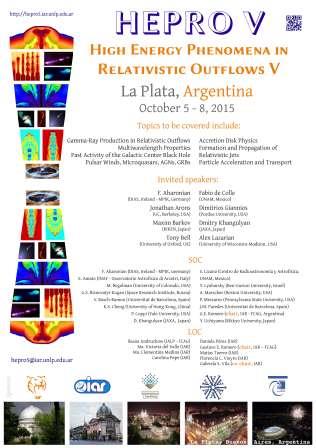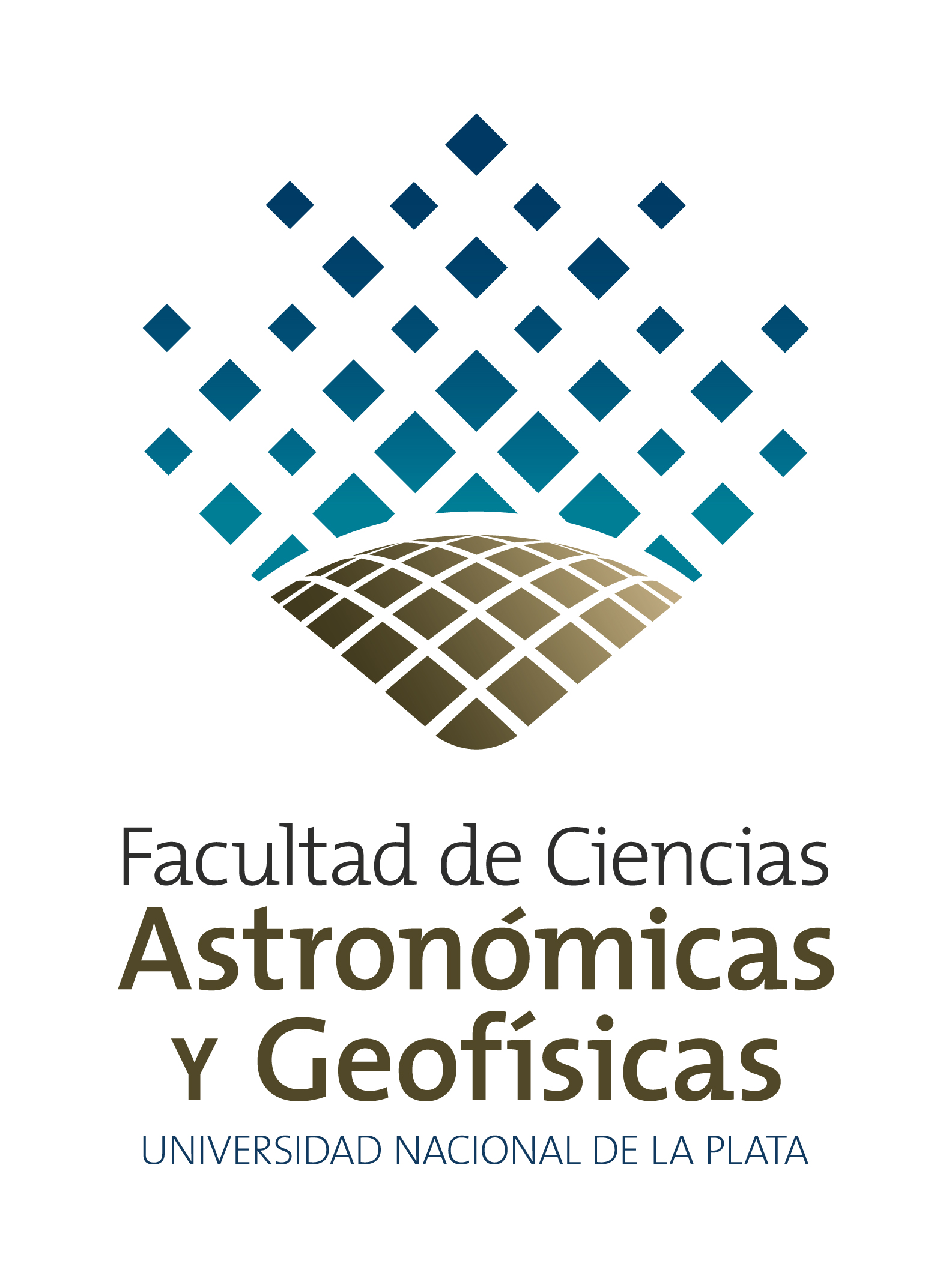- Abraham, Zulema - Jets studies in Latin America
- Araudo, Anabella - Particle acceleration and magnetic field amplification in the hotspots of FR II galaxies
- Bednarek, Wlodek - High energy radiation from globular clusters
- Berton, Marco - Exploring the parent population of beamed NLS1s: from the black hole to the jet
- Bisnovatyi-Kogan, Gennady - Magnetorotational supernovae and jet formation
- Bottcher, Markus - H.E.S.S. observations of extragalactic jet sources
- del Valle, Ma. Victoria - High-energy studies of cloud-disc collisions
- Janiuk, Agnieszka - Non-linear variability in microquasars in relation with the winds from their accretion disks
- Kadowaki, Luís - The role of fast magnetic reconnection in microquasars and AGNs
- Kocharovsky, Vl. V. - Analytical theory of self-consistent current sheets in multicomponent relativistic plasma with arbitrary energy distribution of particles
- López Cámara, Diego - Three-dimensional simulations of variable GRB jets
- Marcote, Benito - Physical properties of the gamma-ray binary LS 5039 through low and high frequency radio observations
- Melioli, Claudio - AGN jets and their interplay with the host galaxy and the central black hole [Movie1] [Movie2] [Movie3] [Movie4]
- Mirabel, Félix - Jet-induced star formation in the reionization epoch
- Moreno de la Cita, Víctor - Coupling hydrodynamics and radiation calculations for star-jet interactions
- Morlino, Giovanni - Mass loading of bow-shock pulsar wind nebulae
- Ng, Stephen C.-Y. - Mapping the magnetic field structure of elongated pulsar wind nebulae
- Paredes, Josep M. - Superorbital variability of the gamma-ray binary LS I +61 303 studied with MAGIC
- Paredes-Fortuny, Xavier - Numerical simulations of the collision of an inhomogeneous stellar wind and a relativistic pulsar wind in a binary system
- Pepe, Carolina - Spectral energy distribution, polarization, and synthetic radio maps of Cygnus X-1: a lepto-hadronic jet model [Movie1] [Movie2]
- Pian, Elena - Relativistic jets: an overview of recent progress
- Riquelme, Mario - Electron heating and heat transport in collisionless accretion disks
- Rodríguez-Kamenetzky, Adriana - High energy processes in protostellar jets
- Sushch, Iurii - Role of the disk environment in the observed TeV light curve from PSR B1259-63/LS 2883
- Tavecchio, Fabrizio - Extreme BL Lacs: probes for cosmology and UHECR source candidates
- Wahlberg, Hernán - Review of the latest results from the Pierre Auger Observatory
Slides of presented talks
Poster presentations
Accepted talks and posters
The complete list of accepted contributions is available in the book of abstracts. Invited talks have a duration of 50 min (40 + 10 for questions), highlight talks 30 min (25 + 5 for questions), and contributed talks 20 min (15 + 5 for questions). The maximum size allowed for posters is 85 cm (width) x 120 cm (height).
Invited speakers
- Zulema Abraham (Universidade de São Paulo)
Jets studies in Latin America
During the decade of 1970, astronomers were discussing the nature of the recently discovered quasars (Quasi Stellar Radiosources), specially their galactic or extragalactic nature. The existence of very small sources in the cores of these quasars was inferred by the first measurements made with VLBI, Very Long Baseline Interferometry, which provided mas resolution. Improvements in the imaging techniques led to the discovery of pc scale jets and components moving with, if extragalactic, superluminal velocities. It was only with the discovery of the galactic microquasars, some of them also presenting jets with superluminal velocity components, that the extragalactic nature of quasars and pc scale jets could not be contested any more. In this presentation I will review the role of Latin American research in the study and understanding of these jets, since the very beginning of its discovery. The studies were made with instruments in Latin America and abroad, especially at radio and optical wavelengths, followed by theoretical studies and numerical simulations. - Jonathan Arons (University of California, Berkeley)
Current sheets in pulsar wind nebulae
I discuss the role of electric current sheets and filaments in mass and magnetic flux transport, and in particle acceleration, in Pulsar Wind Nebulae. - Maxim Barkov (RIKEN, Japan)
Numerical simulations of relativistic jets
We present numerical simulations of axisymmetric, magnetically driven relativistic jets on six decades in spatial scale. To eliminate the dissipative effects induced by a free boundary with an ambient medium we assume that the flow is confined by a rigid wall of a prescribed shape, which we take to be $z \sim r^a$ (in cylindrical coordinates, with a ranging from 1 to 3). We also prescribe, through the rotation profile at the inlet boundary, the injected poloidal current distribution: we explore cases where the return current flows either within the volume of the jet or on the outer boundary. The outflows are initially cold or hot, sub-Alfvénic and Poynting flux-dominated, with a total-to-rest-mass energy flux ratio up to $\mu \sim 15$. We find that in all cases they converge to a steady state characterized by a spatially extended acceleration region. The acceleration process is very efficient: on the outermost scale of the simulation as much as ~ 75 per cent of the Poynting flux has been converted into kinetic energy flux, and the terminal Lorentz factor approaches its maximum possible value ($\Gamma_{\infty } \sim \mu$). - Tony Bell (University of Oxford)
Particle acceleration in radio galaxies
Whereas particle acceleration in supernova remnants is now reasonably well understood, the same cannot be said of particle acceleration in radio galaxies, partly because observation is more limited and partly because of the theoretical difficulties posed by relativistic or mildly relativistic shocks. Acceleration by relativistic shocks is heavily dependent on the strength and orientation of the magnetic field and on the structure of the turbulence that amplifies the magnetic field. Excellent progress has been made in understanding the early stages of acceleration using particle-in-cell codes, but the theory of acceleration to higher energies is very uncertain. Both theory and observation raise doubts about whether relativistic outflows are able to accelerate ultra-high energy (EeV) cosmic rays, and much more work is needed. I intend to review the various issues that make high velocity shocks more challenging than non-relativistic shocks. - Fabio de Colle (Universidad Nacional Autónoma de México)
Gamma-ray bursts: jet propagation
In this talk I will discuss our understanding of the gamma-ray burst (GRB) jet dynamics. Observations show that long GRBs are associated with the collapse of massive stars, which leads to the formation of an ultra-relativistic jet moving with Lorentz factors up to ~ 200-1000, often associated with an energetic supernova. As the jet propagates through the star, its interaction with the stellar material shapes the resulting supernova. Then, as the jet breaks out of the star and freely expands in the environment, dissipation of kinetic energy in internal shocks and/or at the jet photosphere produces the gamma-ray emission (the "prompt emission"). Finally, as the relativistic flow decelerates, it produces a multi-wavelength afterglow which can be observed in radio during several years. These different stages of evolution of the GRB jet will be described in detail in this talk, focusing in particular on how the interaction of the jet with the environment and the associated dissipation of kinetic energy leads to a powerful multi-wavelength emission extending from gamma to radio frequencies. - Dimitrios Giannios (Purdue University)
Flares in relativistic jets from tidal disruption events
The tidal disruption event (TDE) of a star by a supermassive black hole provides us with a rare glimpse of these otherwise dormant supermassive black holes in galactic centers. It has long been predicted that the disruption will be accompanied by a thermal "flare", powered by the accretion of bound stellar debris. A dozen of such TDE candidates have been discovered the past 15 years. The year 2011 marked a new era of TDE theory and observations when it became clear that a substantial fraction of the power released during the TDE can be channeled into an ultra-relativistic outflow. The X-ray transient Sw 1644 57 and its more distant twin, Swift J2058, provide strong support to the presence of powerful relativistic jets during tidal disruption events. I will discuss the rich behavior of Sw 1644 57 in the radio and X-rays and the valuable lessons it can teach us in terms of jet physcis, super-Eddington accretion as well as for the circum-nuclear medium in quiescent nuclei. - Dmitry Khangulyan (Japan Aerospace Exploration Agency)
High-energy emission from relativistic jets
Observations in gamma rays provide a very important window to study physical processes underlying the spectacular phenomenon of relativistic jets. Spectral properties and variability information obtained with spaceborne and ground-based gamma-ray detectors provide many constrains on the physical conditions in the gamma-ray bright region and on its location. These constrains however do not favor some specific scenario for non-thermal emission, but rather put further challenges for modelling. In this talk, I will review the recent progress in the field of modelling of the gamma-ray emission from various jetted sources. - Elena Pian (Scuola Normale Superiore di Pisa / INAF-IASFBO)
Relativistic jets: an overview of recent progress
Multi-wavelength observing campaigns in the last decade have revealed a great deal of detail about the behavior of extragalactic jets, and particularly of their most extreme manifestations, i.e. blazars and gamma-ray bursts. Variability in these sources offers an unequalled view on the powering mechanisms: patterns vary from source to source and from epoch to epoch and over a wide range of luminosities. Ultimately, the accurate mapping of jets through multi-wavelength monitoring will disclose the nature and working regimes of the inner engines. I will review some of the most revealing observations of relativistic jets of both blazars and gamma-ray bursts. - Anatoly Spitkovsky (Princeton University)
Particle acceleration in relativistic outflows
I will review progress in kinetic modeling of particle acceleration in relativistic sources, concentrating on acceleration in collisionless shocks and magnetic reconnection. Particle-in-cell simulations enable ab-initio study of the injection, acceleration and magnetic field amplification in shocks. Dependence of acceleration efficiency on shock speed and magnetic inclination has now been explored for a range of parameters from non-relativisitic to relativistic shocks. Magnetic reconnection can also contribute to the formation of energetic tails and to dissipation in Poynting-dominated outflows. Characteristic spectra and acceleration mechanisms of relativistic reconnection will also be discussed.











